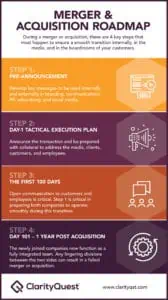When executive teams begin considering M&A activity, they generally start with their corporate growth strategy in mind. A company’s growth plan may include a variety of strategic elements including organic growth of revenue streams through product or market diversification or more immediate growth through M&A activity.
While early-stage M&A programs focus on due diligence activities and evaluations of corporate financial statements, solvency, revenue performance, and even corporate reputation and cultural “fit”, one of the key components of a successful merger or acquisition is the communication, marketing, and integration plan.
According to management consultant KPMG, “83% of all mergers and acquisitions failed to produce any benefit for shareholders and 61% actually destroyed shareholders’ wealth”.
Executing a successful marketing strategy specifically designed for the merger or acquisition can greatly improve these numbers.
Beyond the boardroom – M&A integration and marketing plans
So your executive team has found the perfect companion company, at least on paper. A Letter of Intent or Memo of Understanding has been signed. The executive suite may now look to marketing and sales leadership to plot the course through the next phase of the acquisition.
This next phase will likely be much more focused on communication, both public and internal, and the integration plan that will bring two organizations under one corporate umbrella.
There are 4 key steps that must take place to ensure a smooth transition internally, in the public/media eye, and in the halls and boardrooms of your customers. A well-planned acquisition marketing plan will be your silver bullet to put your company on track to reap the financial gains the merger was intended to deliver.
 Step 1: Pre-announcement
Step 1: Pre-announcement
During this phase, key messages are defined that will be part of every internal and external communication. Think your M&A is too small to worry about this? You’re wrong. Even the merger of a single product line or a warehouse needs to be properly positioned to customers, key analysts, sales teams, etc.
Other items to consider include branding, communication timelines, cross-functional involvement, HR impacts, current and acquired customer communication, websites, and social media.
Pro-tip: Identify members of key cross-functional teams to guarantee a synchronized plan.
Step 2: Day-1 tactical execution plan
This is the “go-live” day when the transaction is announced. Marketing tactics might be as simple as hanging a banner in the lobby of a new location, or as big as launching a full media blitz.
Make sure you have a plan, complete with collateral, press release, Q&A, and a management team that has been prepped and knows how to address key customer and employee concerns. Step 1 helps ensure Announcement Day goes off without a hitch.
Step 3: The first 100 days
The key integration phase, the first 100 days, really tells the story of how prepared you are and how much up-front planning you did in the earlier steps. Teams come together, operations have to flow smoothly to avoid interrupting current sales cycles (for both companies), and employees need to feel good about the new path to corporate success.
During this phase, “walking the talk” is critical. Don’t fail to communicate internally and externally. Repeat key messages and keep everyone “in the know” from customers to employees. Leverage the cross-functional teams that were identified in Step 1 to keep the momentum going strong and communication lines open — the success of this merger depends on it.
Step 4: Day 101 – 1 year post acquisition
In this phase, the newly joined company transitions fully to a smooth-running, fully integrated team member. If the plan was to fully integrate, there should be no more “them and us” in the hallways or with customers. Everyone is on board and the letterhead, domain names, email addresses, etc. are all one company.
Operationally, the marketing and sales teams have a common CRM system, prospect database, sales funnel, and forecasting methodology. In the back-office and warehouse, orders are fulfilled seamlessly under one PO with one contract. Companies that allow lingering division in essential departments risk never having a fully combined team. This is the root of many failed mergers and acquisitions.
What’s your M&A marketing strategy?
Following a merger or acquisition marketing plan based on the above steps will put you on the road to a successful merger.
Need help crafting your M&A marketing strategy? Partner with a healthcare marketing agency that understands your organization’s needs in this ever-changing M&A business climate.
Note: This post was originally published in 2017 and has been updated to reflect current trends.


 Step 1: Pre-announcement
Step 1: Pre-announcement
